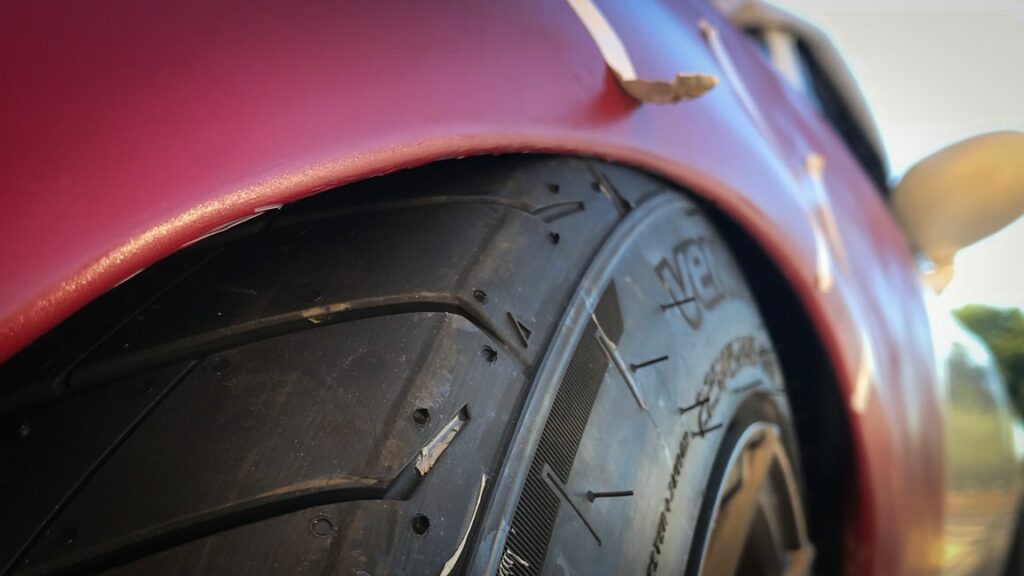If you’ve been around cars long enough, you’ve probably seen staggered wheels on a car or two. Sometimes it’s very subtle, but other times ultra-wide wheels with zero or negative offset on one end of a vehicle can be hard to miss.
But what exactly do staggered wheels do, and what are their advantages? More importantly, are they something you should put on your vehicle?
In this comprehensive guide, we’ll dive into everything you need to know about staggered wheels and help you decide if they’re right for your car.
What Are Staggered Wheels?
Staggered wheels are also known as offset wheels. It’s when one axle has different sized wheels than the other axle. Don’t confuse this with the wheel offset itself though! That relates to the offset of the individual wheel.
Typically, the rear wheels are slightly larger than the front wheels, but if you drive a front-wheel-drive vehicle, you’ll need to reverse the setup to see any advantages. So, staggered wheels are a little bit more than big tires in the back and small in the front.

Staggered wheels come in two main variations.
The first variation refers to the width of the wheel. It’s the first three numbers in a tire size, and it’s the easiest way to stagger your tires. This way you can make small changes to a tire’s width without changing the rims or any other components.
The second variation of staggered wheels requires a bit more work. You might have heard of the term staggered rims. So what are staggered rims, and what does having staggered rims mean?
Simply put, it’s when you change the rim size — which results in a tire with a wider diameter.
Some drivers prefer larger rims instead of wider tires but to do this, you’ll need to make sure that your vehicle has enough clearance after you install the new wheels.
Benefits of Staggered Wheels
There are a few benefits to staggered wheels, the most prominent being better traction. If you have a rear-wheel-drive vehicle, the majority of your traction is coming from the rear tires.
But what are the advantages and benefits of staggered wheels vs non-staggered?
The wider the tire, the more surface area your tire has to grip the pavement with. While you might think that wider tires lead to more friction which slows you down, the improved traction’s added benefits easily offset this loss.
You need tires that can grip the road to make the most of the torque that your engine creates. The bigger your tire, the more surface area they have to grip the road.

Disadvantages of Staggered Wheels
It’s not all rainbows and butterflies with staggered wheels. While they do offer distinct advantages, you need to be aware of the drawbacks too.
Uneven Tire Wear
For starters, you’ll notice that your wheels likely won’t wear evenly. Larger tires with more surface area will grip the road more for better traction, but all this traction will also cause them to see uneven tire wear.
Furthermore, you’ll need to install larger tires on the correct axle. For instance, if you drive a front-wheel-drive car and install bigger rims in the rear, you won’t get any performance benefits.
Instead, you’ll get decreased handling and less braking power. This works the same way if you drive a rear-wheel-drive vehicle and install the larger wheels on the front.

Remember, rotating your tires is no longer something you can do from front to rear, you can only swap from left to right. Similarly you’ll need to check your tires use different pressures on both front and rear axles.
Decreased Braking Performance
Another drawback is that staggered wheels decrease braking performance, but this is only true if you’re increasing your wheels’ width and not your brakes.
Bigger wheels give you better traction, but it also makes your brakes work harder to stop them from spinning.
So if you’re increasing your rim width, upgrading your brakes is the next thing to do. Otherwise, you’re risking significant braking concerns.
Shorter Maintenance Intervals
Staggered wheels not only affect performance but also impact your maintenance intervals.
Yes, you’ll get better traction and better handling if you do everything right, but all of that takes a toll on other car components too.
Furthermore, they can lead to some components wearing out prematurely. Not only do your brakes wear out sooner, but your tires will too.
Moreover, if your vehicle is still under warranty the manufacturer might void your warranty if you’re using anything other than the recommended tire size.
Staggered Wheels Setup
Once you’ve decided you want the benefit that comes with staggered wheels, you have to find the perfect staggered wheel setup for your vehicle.
If you’re simply upgrading your tire width, it’s one of the more straightforward modifications to set up. When replacing your tires, simply put larger wheels on the rear axle than the front.
Keep in mind that there’s a lot more to this than finding bigger tires and slapping them on your vehicle. You’ll still need to verify the staggered fitment. You can usually add or subtract 15 to 20 millimeters from your tire’s width before you’ll run into any problems.
Additionally, it’s good to double-check that your new tires aren’t rubbing on any other components after you install them. You may need to use a fender rolling tool to roll the “lip” of your fenders up, and may need to use it to “pull” your fenders out too.

However, if you plan on upgrading your tire width further or if you want to increase your rim size, the process is a bit more expensive, but it’s usually pretty straightforward too.
In addition to purchasing larger rims, you may need larger brakes to handle the added weight. Remember, it’s best to measure everything before ordering to make sure the new rim size will fit.
On the other hand, if it’s your front wheels that you are making changes to, make sure you measure the clearance of both — when you have the wheel straight and when it’s completely turned. If it doesn’t fit at any point, you may need to use some wheel spacers and probably spend some more time massaging your fenders.
Other Ways to Improve Traction
While swapping your tires is one of the easiest ways to improve traction, it’s not the only option at your disposal.
Another easy way to add traction to a rear-wheel-drive vehicle is to add weight to your vehicle’s rear. Those living in snowy climates have used this trick for many years.
More weight pushes the tires down harder, and this increases traction. However, if you’re looking for performance — you’re trying to cut weight, not add it.
Other ways to improve traction and vehicle handling include upgrading your vehicle’s suspension system components like:
- Performance shocks
- Leaf springs
- Torsion bars
While they won’t increase your vehicle’s traction to the same degree that larger tires would, they do help. If bigger tires or rims don’t fit your vehicle, this might be the only viable option without spending a ton of time and money retrofitting your vehicle.

Staggered Fitment: Is It Right for You?
On the right car, staggered wheels offer a nice performance boost and it doesn’t hurt that they also enhance the look of your vehicle too.
There’s a reason why they’re so popular at the track, but even if you never plan on racing your vehicle, larger tires improve your vehicle’s handling too. Better traction, better braking, and sharper turning are just a few of the performance advantages you get with staggered wheels.
Whether you’re looking for wider tires or bigger rims, both are a great option to enhance your vehicle. And if you’re stuck between the two, why not pick both?
Like what you’ve read here or have questions? Leave me a comment below!


1 comment
Hello,
I have an Acura TLX ASPEC 2022, and I’ve had the car for approx., 4 Months and out of those 3/4 Months, I’ve been using a Staggered Set Up. I currently run Front 20×9 +35 w/ 235/35/R20 XL and Rear 20×10 +40 265/35/R20 XL. I was pretty new at this stuff and I had someone from a Good Website/Reviews help me out, but I question if the fitment is not good. I haven’t had any problems with the Car as of yet, but still wondered if this is fine.